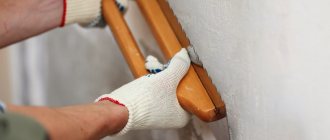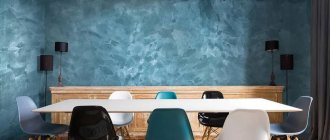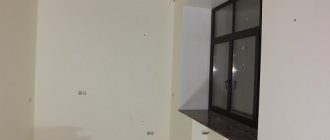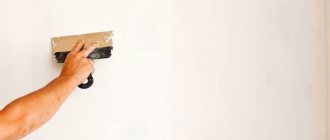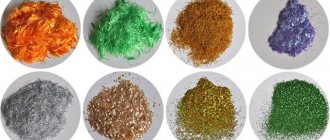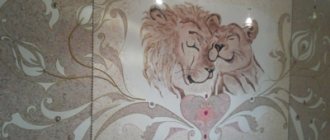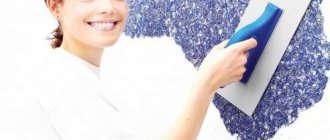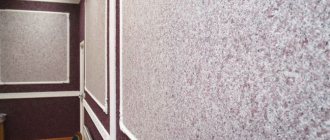Liquid wallpaper is a decorative finishing coating that combines the properties of plaster and classic roll wallpaper for painting. The material does not contain sand. Its basis is cellulose. It is possible to add silk fibers, dyes, plasticizers and decorative elements, such as glitter, mother of pearl, mineral chips and other additives that make the coating unique. Despite the difference in composition, there is something in common between finishing plaster and liquid wallpaper: this is the method of application.
Advantages and disadvantages
Liquid wallpaper has long ceased to be an exclusive finishing material. Ready-to-use mixtures can be purchased at any hardware store. It is enough to dilute them with water in accordance with the instructions and you can begin finishing. Some may find it much easier to work with rolled materials. However, liquid wallpaper has such a list of advantages that you can forget about some of the inconveniences.
Advantages of the material:
- seamless application technology allows you not to think about combining design elements on adjacent canvases;
- Before applying, you don’t have to level the walls too carefully. The thickness of the layer is sufficient to hide minor irregularities;
- liquid wallpaper is so elastic that it will not crack during shrinkage, which is inevitable in new homes;
- this material provides high sound and thermal insulation;
- using several shades of liquid wallpaper, you can decorate the walls in the form of an exclusive panel;
- There is virtually no waste left after the work is completed.
The disadvantages include the following:
- the porosity of the texture increases the drying time of the coating to 48 hours;
- Due to its high hygroscopicity, the material is not recommended for use in rooms with high humidity.
In order to save material consumption and increase the service life of the decorative coating, it is recommended to apply it to a primed base.
Primer selection
Pre-processing solves several issues at once:
- cleans from dust;
- increases the strength of the base;
- promotes uniform application of liquid wallpaper;
- reduces the hygroscopicity of the base surface;
- prevents the appearance of mold and mildew;
- increases adhesion between the base and finishing material.
Primer of the base for liquid wallpaper is a prerequisite for its high-quality application. Which mixture to choose depends primarily on the texture of the wall. Ideally, it is recommended to buy treatment compounds and liquid wallpaper from the same manufacturer.
Preparing liquid wallpaper for application
The process of preparing liquid wallpaper lasts from 10 to 12 hours. Therefore, it is necessary to start preparing them in advance (you can even immediately after priming the walls).
A package of liquid wallpaper may contain several components at once. After pouring all the ingredients (except for decorative additives) into one large container, its contents should be mixed without adding water. Before mixing with water, it is advisable to fluff the mixture with your hands. This is done in order to get rid of stuck together lumps.
Decorative fillers (dyes, glitter, etc.), stored in separate packaging, should be dissolved in water before the main ingredients (dry glue mixed with cellulose and silk base) are added to it. This is always done to create a more even texture.
Types of compounds
Today, several types of primer coatings are offered on the finishing materials market.
- Universal, acrylic based - Quick-drying coating. Easy to apply to the surface, non-toxic. Suitable for all types of substrates.
- Alkyd - Used exclusively for treating wooden walls. Complete drying time 15 hours. Use on gypsum and plastered surfaces is not advisable.
- Deep penetration acrylic primer - Often made with tinting and can be used as an intermediate paint coat. Deep-penetrating and well-absorbing mixture. Suitable for putty and plasterboard surfaces. Strengthens outdated, weakened and porous walls that highly absorb moisture. Can be used in conditions of high humidity.
- Water repellents - Organic binders that create a protective film. Available in the form of concentrates that must be diluted in accordance with the manufacturer's instructions.
- Deep penetration quartz mixture Betonokontakt - Designed for treating all types of surfaces. Finely dispersed quartz filler allows you to create a rough base for applying any finishing materials, including liquid wallpaper.
Important!!! Before treatment, the surface must be cleaned of dust and mechanical impurities. Oil stains and islands of corrosion can subsequently appear through the coating and spoil the appearance of the finish.
One of the features of choosing a primer is the need to focus on the color of the composition. It is not recommended to strengthen the base with tinted compounds, especially if the color of the liquid wallpaper is light. The best option for preparing walls are transparent or white compounds.
White primer is ideal. With its help, you can achieve uniform color of the walls, and the area that has already been treated is immediately visible. Its use is especially important on dark concrete bases.
When purchasing, you need to pay attention to the purity of the color (the composition should be transparent or white without impurities) and the expiration date. An expired primer will not provide sufficient adhesion.
For treating concrete walls for painting or applying liquid wallpaper, there is another alternative surface preparation option.
Instead of a primer for liquid wallpaper, you can use PVA glue. To obtain the composition of the correct consistency, it is diluted with water in a ratio of 1/2 or acrylic paint in a ratio of 1/3. This budget option has its drawbacks:
- does not increase the strength of the base because it cannot penetrate deep into the base;
- does not protect against mold and mildew;
- changes color and texture over time;
- may peel off under the weight of the decorative coating.
Since liquid wallpaper is an expensive finishing material, it makes no sense to save on primer.
Briefly about liquid wallpaper
Liquid wallpaper is sometimes referred to as “silk plaster”, this name was introduced by one of the brands - Silk Plaster. This finish has many advantages, but is not without disadvantages, including sensitivity to substances in the thickness of the wall that actively interact with water and water solubility. The latter can be eliminated by applying colorless varnish to the wallpaper.
To prevent peeling of the material, various options are used, for example, PVA primer or other homemade compositions. But, if you weigh all the pros and cons, it turns out that using a professional primer mixture is not a waste of money, but a reasonable saving in the long term.
Features of the wall surface
Preparing the base for applying liquid wallpaper consists of cleaning it, leveling it and priming it. If the first two stages are identical for all surfaces, then the last one depends on the characteristics of the base.
Concrete and plastered
The peculiarity of concrete and plastered bases is their increased hygroscopicity. The treatment of such walls for the application of liquid wallpaper takes place in several stages:
- Treatment of the base with deeply penetrating compounds:
- Puttying and surface leveling.
- Cover with additional layers of primer.
- Coating the wall with water-dispersion or oil paint.
Only after the last coating has completely dried can liquid materials be applied.
Drywall
Unlike porous and not always smooth concrete walls, plasterboard sheets have a smooth surface, the processing of which takes much less time, but has its own characteristics:
- Before applying the primer, you must carefully fill the joints of the material sheets and the recesses left when tightening the screws. To ensure uniform color of the finishing material, it is recommended to putty the entire wall.
- Treat the walls with 2-3 layers of deep penetrating primer.
- The metal fastener caps protruding above the base must be painted over with any waterproof coating.
Wooden base
Moisture negatively affects wood. Under its influence, it begins to swell and rot, so walls made of this material require more careful processing:
- The entire area of the wooden base is covered with special antiseptic impregnations.
- The surface is primed in several layers. In this case, it is necessary to choose compounds intended for processing wood specifically.
- Finally, it is necessary to cover the base under the liquid wallpaper with water-dispersion paint.
You can begin finishing work only after the last protective layer has completely dried.
Painted walls
For smooth, well-painted walls, the following preparation options are possible:
- It is recommended to sand the glossy slippery coating with fine-grained sandpaper to give it the necessary roughness. Then degrease the surface and treat it with quartz primer.
- The matte porous coating must be primed in order to reduce the hygroscopicity of the surface.
If the paintwork on the wall is cracked and partially crumbled, it must be removed and the cleaned surface treated in accordance with the recommendations for the base material.
Surface Requirements
In order for the finish to be smooth, beautiful, and without flaws, it is worth carefully preparing the surface.
The foundation must have some important requirements:
- there should be no large cracks on it;
- there should be no areas with old coating;
- low moisture absorption;
- high color fastness from development on paint.
Preparation is of particular importance. First, the base needs to be cleaned of old finishing materials. Next, you need to fill the cracks and small irregularities with putty. After this, finishing priming is carried out.
Preparing the surface for priming
Before applying the primer, it is necessary to pre-treat the surface. Preparation of the base takes place in two stages:
- Cleaning up. At this stage, the walls are cleaned of the remnants of the old finish (pieces of plaster, putty, wallpaper, etc.). If this is not done, during operation they may peel off along with pieces of liquid wallpaper. It is also necessary to remove rust and oil stains from the surface.
- Leveling the surface. All cracks, dents and chips need to be filled. A layer of decorative coating can correct only minor differences in wall level and microcracks.
Preparing the base
Before you begin applying a primer for liquid wallpaper, it is necessary to remove the old decorative coating, peeling plaster, lime, and foreign inclusions.
Metal fasteners and fittings are treated with alkyd paint or primer so that rust does not appear on the decorative finish later.
If mold is present, it is treated with antiseptics and water-repellent compounds. If there are cracks, they are widened, but they are sealed with putty only after priming once. After leveling the base, primer is applied again.
Tools and instructions
To properly process the base, you need to prepare the tools for work and become familiar with the procedure for carrying out the work.
To apply the composition you will need:
- paint roller (preferably polyamide with short or medium pile);
- medium sized flat brush. It is recommended to use a tool with synthetic fiber. It has less climbing and is more durable;
- a tray for diluting the primer;
- gloves.
The procedure for surface treatment is as follows:
- the finished composition is poured into the prepared container, the dry mixture is poured out and diluted in accordance with the manufacturer’s instructions;
- the roller is impregnated with the solution, lightly squeezed and begin to roll over the surface, making sure that the primer does not spread, but is absorbed;
- It is recommended to use a brush to treat corners and hard-to-reach places;
- Smooth walls that do not absorb the composition well must be rolled several times in the same place. When moving to the next section, it is necessary to re-wet the roller;
- After finishing work, the roller and brush must be thoroughly rinsed. If you do not do this right away, the composition will harden and the instrument will have to be thrown away.
Important!!! Applying the second layer must be done only after the first has completely dried. You can tell that the primer has hardened by touch. Fingers do not stick to a dry surface.
Common mistakes and their consequences
The process of applying liquid wallpaper to walls requires attention and patience. Haste and violation of technology for working with this material can be expensive. Most beginners make the following mistakes:
- It is believed that a well-painted glossy base does not require additional processing. Result: poor adhesion to the surface.
- Add too much water. Result: the composition turns out to be too liquid and not elastic, so it has to be applied in a thicker layer.
- Smooth but rough walls should not be treated with primer. Result: a surface with increased hygroscopicity absorbs moisture from the decorative coating.
All these mistakes lead to a large waste of material, which significantly increases the cost of finishing work, because liquid wallpaper is not cheap.
Expert advice
To make the process of finishing a room with liquid wallpaper easy and successful, you need to take into account the advice of experienced builders.
Important expert advice includes:
- For drywall, it is recommended to use compounds with deep penetration. This can reduce the absorbency of the material.
- It is recommended to align the existing screw heads and joints well and sand them with sandpaper. The caps of the fastening components can be sealed with oil, latex paint or enamel, this will prevent metal corrosion.
- For wooden walls, a primer with waterproofing properties is suitable. It will prevent deformation and fungus formation.
- Uneven tone on wood or painted surfaces may show through wallpaper. For this reason, it is recommended to pre-paint them with white paint or to match the color of the topcoat.
- The choice of primer should be approached carefully, having studied the composition, its service life, type and purpose.
The primer layer creates a strong adhesion of the material, which ensures high-quality and uniform application of the coating. At the same time, do not forget about the base of the surface, because for each material it is worth using a certain type of primer.

